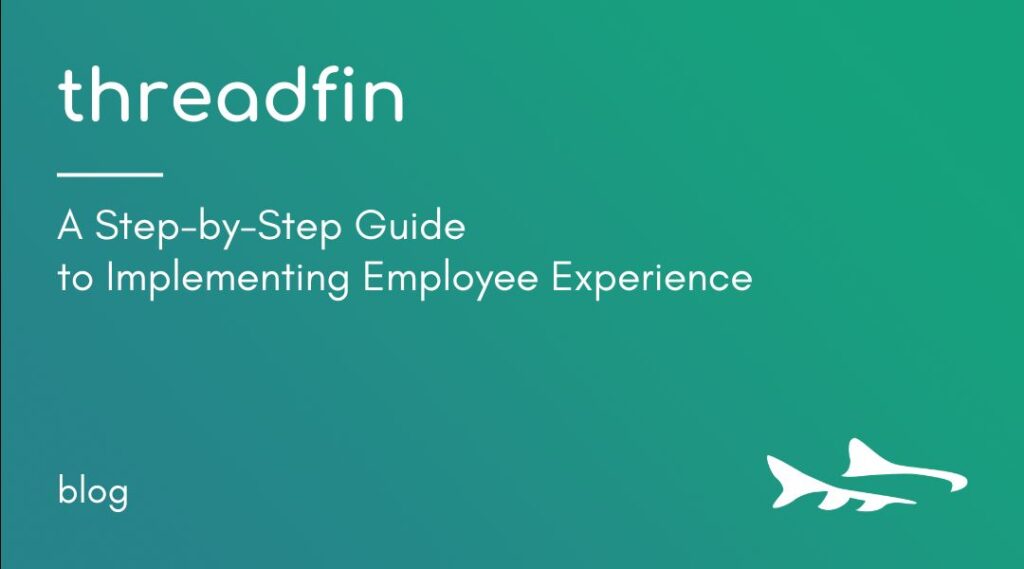As more and more companies begin to focus on employee experience (EX) to create an atmosphere of positive change, they’re using digital transformation to enable their employees to deliver superior experiences to their customers, and ultimately drive value across the entire organization. While it may seem daunting to build and implement positive employee experience into your business model, here Diane Magers, CCXP, Threadfin’s Experience Practice Lead (and Founder and Chief Experience Officer at Experience Catalysts) outlines the seven key steps in moving toward employee-centricity:
Building and Implementing the Discipline of Employee Experience
1. Get leadership buy-in. Help your leadership team understand the relationship and business impact of employee and customer experience by creating examples and developing a business case for your leaders. To prove why employee experience is a worthwhile investment, you’ll need to clearly explain the current gaps and inefficiencies
in employee experience, and how it ties back to the customer experience and the brand’s bottom line.
2. Create a cross-functional team. With support from your executives, charter a cross-functional team with deep, lasting knowledge of the processes, programs, and frameworks that make your company tick. Focus on understanding the current employee experience: What do you know about your employees today? How long are they staying? Why are they leaving? What pain points, challenges, and barriers do they face each day? Conduct interviews, review previous employee surveys, and gather as much information as possible about employees’ experiences.
3. Map the employee journey. After the data collection phase is complete, it’s time to create an employee journey map. This should comprehensively represent what a typical employee goes through every single day in their work environment — from their hurdles to their frustrations and needs. A critical component of this mapping step should identify where the employee journey links, and how it impacts the customer experience journey.
4. Prioritize. Next, identify potential opportunities to redesign the highest-friction experiences that your employees face, or where they need empowerment, data, tools, resources, and leadership in order to succeed. To start, perform a quick impact and value analysis. In other words, which opportunity, if solved, would have the most impact and be most valuable to employees and the company? Identify a few quick wins, and create a roadmap to tackle other opportunities.
5. Purposeful design. Now that you’ve determined the opportunities to start with, and discovered the right issues or opportunities to solve, you’ll start to design the new experience, and put plans in place to fix the problems. This critical step focuses on ensuring that the design of an experience is done intentionally, and addresses specific goals aimed at creating lasting business value through experience. After you’ve implemented the changes, tell your story! Highlight tangible and intangible results you expect to receive from the project (or several projects) to build momentum, demonstrate the results of improving employee experience, and capture the impact the changes have on your customer. Caution: Don’t just focus on metrics such as NPS (Net Promoter Score) or CSAT/ESAT (Customer or Employee Satisfaction). Instead, ensure your project measures impacts such as increased productivity, reduced cost-to-serve or cost-for-acquisition, and the number of additional services sold. These translate directly to distinct financial results.
6. Pilot. Use a pilot approach to design an ongoing experience discipline that introduces systematic changes to improve your employee experience. Build business cases and demonstrate how employee experience creates strong engagement for your employees, and how it has a cascading effect on improving customer experience.
7. Incorporate the discipline. Build a steady voice for the employee, and create ways for them to participate in innovating the experience by providing input into the solutions. Build out ways to test and iterate on what’s working and what’s not working. Focus on the impact, and deliberately put structure in place that enables your company to make changes while continually improving employee experience systematically.
Positive results require a commitment to identifying and improving the employee experience with the same rigor you apply to customer experience—and identifying and creating a series of programmatic changes and investments that deliver meaningful impact from engaging employees and customers.
Diane says, “At the core, it’s about building an approach to continuously improve the experience in your company’s entire ecosystem. This central approach will not only drive business results, but also help with agility, collaboration, and innovation, ultimately enabling your company and culture to grow and thrive in a dynamically changing world!”
Learn more about Employee Experience here.
Experience Threading
Digital technology isn’t always human-centered, and that can make it harder for employees to get work done and best serve their customers. Positive results require a commitment to identifying and improving the employee experience with the same rigor applied to customer experience, and then identifying and creating a series of programmatic changes and investments that deliver meaningful impact.
By understanding what employees need and want, engaging them in the design of the digital solutions, you can increase adoption, raise productivity, improve collaboration and innovation, and build engagement and longer tenure, advocacy and referrals, and reduced costs.
At Threadfin, we’re focused on continuously improving the digital experience for employees and their customers to create happier, faster, smarter, and safer ways of getting work done every day — from any device, from any place.
Threadfin’s Experience Threading results in human-centered digital transformation solutions that are tailored to the way your employees get work done, even as that changes over time.

